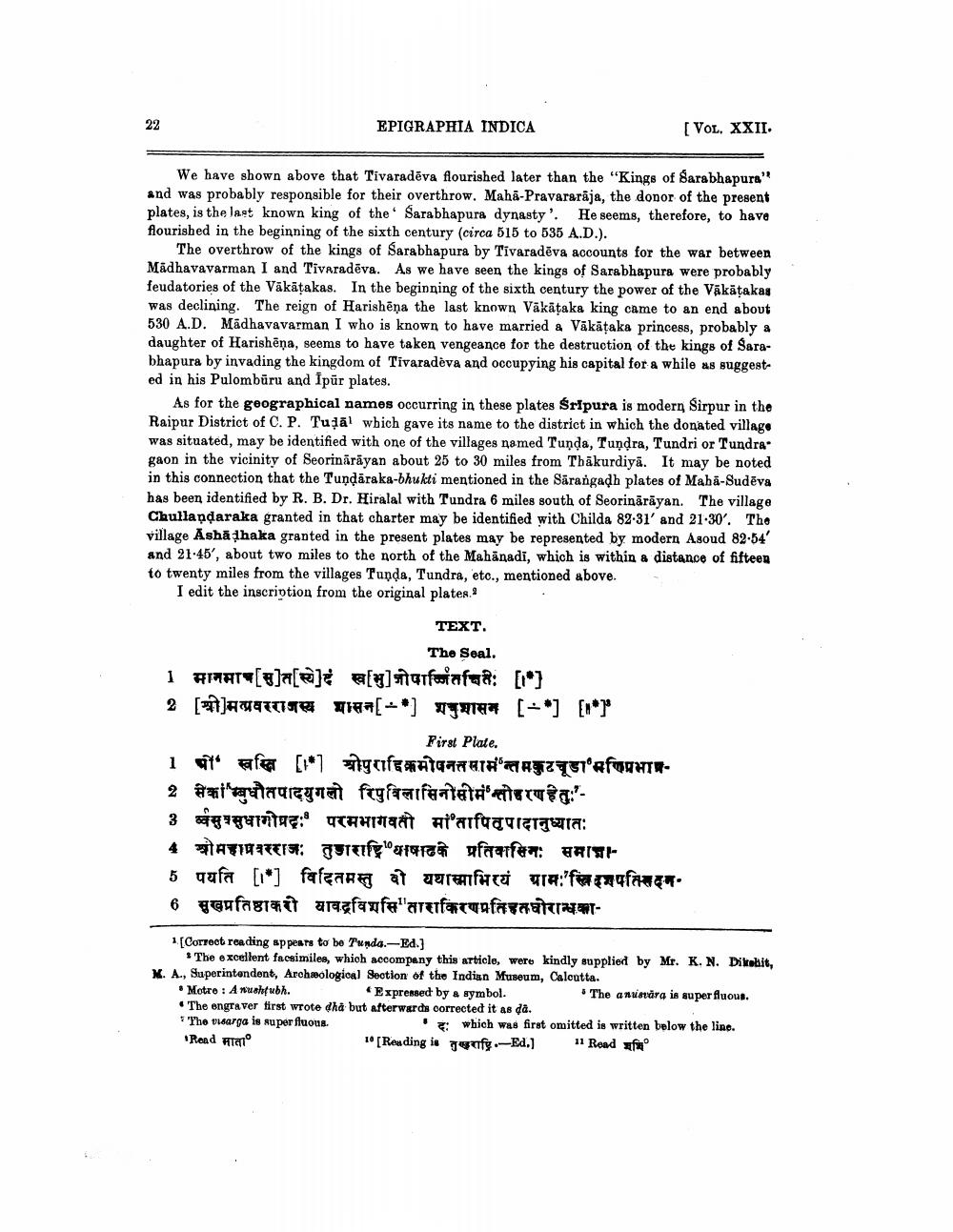________________
22
EPIGRAPHIA INDICA
We have shown above that Tivaradeva flourished later than the "Kings of Sarabhapura" and was probably responsible for their overthrow. Maha-Pravararaja, the donor of the present plates, is the last known king of the Sarabhapura dynasty'. He seems, therefore, to have flourished in the beginning of the sixth century (circa 515 to 535 A.D.).
The overthrow of the kings of Sarabhapura by Tivaradeva accounts for the war between Madhavavarman I and Tivaradeva. As we have seen the kings of Sarabhapura were probably feudatories of the Vākāṭakas. In the beginning of the sixth century the power of the Väkäṭakas was declining. The reign of Harishēņa the last known Vākāṭaka king came to an end about 530 A.D. Madhavavarman I who is known to have married a Vākāṭaka princess, probably a daughter of Harishēņa, seems to have taken vengeance for the destruction of the kings of Sarabhapura by invading the kingdom of Tivaradeva and occupying his capital for a while as suggested in his Pulomburu and Ipür plates.
As for the geographical names occurring in these plates Sripura is modern Sirpur in the Raipur District of C. P. Tuḍal which gave its name to the district in which the donated village was situated, may be identified with one of the villages named Tunda, Tundra, Tundri or Tundra gaon in the vicinity of Seorinarayan about 25 to 30 miles from Thakurdiya. It may be noted in this connection that the Tunḍaraka-bhukti mentioned in the Sarangadh plates of Maha-Sudēva has been identified by R. B. Dr. Hiralal with Tundra 6 miles south of Seorinārāyan. The village Chullaṇḍaraka granted in that charter may be identified with Childa 82-31' and 21-30'. The village Asha ḍhaka granted in the present plates may be represented by modern Asoud 82-54' and 21-45', about two miles to the north of the Mahanadi, which is within a distance of fifteen to twenty miles from the villages Tunda, Tundra, etc., mentioned above.
I edit the inscription from the original plates.
TEXT. The Seal.
1 मानमाच] [] [स्ये] स्व[भु] त्रोपानंतचित [1]
2 [श्री] प्रवरराजस्य
शासन[] मनुशासन [] [1]
1 wit' werfier [1° स्वस्ति [*7
First Plate.
श्रीपुराद्दिक्रमोपनतसा मं'न्त मकुट चूडामणिप्रभात्र
[VOL. XXII.
2 से बुधौतपादयुगलो रिपुविलासिनोसीमं 'तोहरण हेतु :
3
सुरसुधागोमट्ः परमभागवती मातापितृपादानुध्यातः
4 श्रोमचाराजः तुङाराष्ट्रियावाट के प्रतिवासिनः समाज
5 पयति [ 1 *] विदितमस्तु वो यथास्माभिरयं ग्रामः' स्त्रिदशपतिसदन
6 genfare
amafanfe"arifienfiwwerWT
1[Correct reading appears to be Tunda.-Ed.]
The excellent facsimiles, which accompany this article, were kindly supplied by Mr. K. N. Dikebit, M. A., Superintendent, Archaeological Section of the Indian Museum, Calcutta.
The anusvara is superfluous.
Motre: Anushṭubh. Expressed by a symbol. The engraver first wrote dha but afterwards corrected it as da. The visarga is superfluous. which was first omitted is written below the line. Read Ha
10 [Reading is afg.-Ed.] 11 Read f




